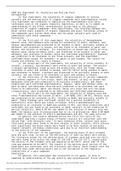Other
CHEM 6AL Experiment #1: Solubility and Melting Point Lab Report
- Course
- Institution
CHEM 6AL Experiment #1: Solubility and Melting Point Introduction In this experiment, the solubility of organic compounds in various solvents and the melting point of organic compounds were experimentally tested. This experiment was conducted to familiarize the experimenters with basic techniq...
[Show more]



